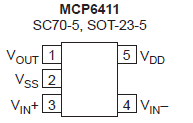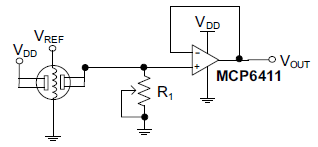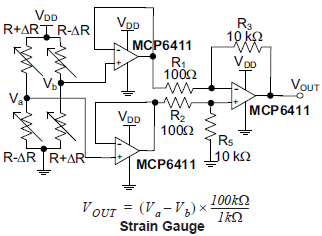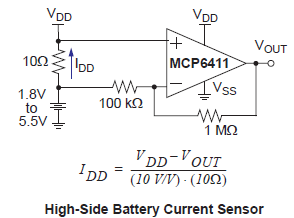Microchip's MCP6411 Operational Amplifier can operate at voltages of 1.7 V and has a quiescent current of only 55 uA (max). The product gain x passband is 1MHz. This combination of features makes this component ideal for portable applications. See in this article some possible applications of this component, suggested by Datasheet (*).
In addition to the features indicated, MCP6411 has improved EMI protection, which is important in applications subject to this type of problem.
MCP6411 comes in SC70-5 and SOT-23 enclosures being built with an advanced CMOS process.

In Figure 1 we have the package and pin identification of this component.
The main electrical characteristics of this component are:
Vdd - Vss: 6.5 V (max)
Current on the analog input pins: +/- 2 mA (max)
Output pin current: 2 mA (max)
Source rejection: 75 dB (min)
CMMRR: 65 dB (min)
Signal gain without feedback: 95 dB (min)
Power: 1.72 to 5.5 V
Quiescent current: 45 uA (tip)
GBWP: 1 MHz
Here are some practical application circuits for this component.
Carbon Monoxide Sensor
This application aims to detect the presence of carbon monoxide (CO) gas in an environment, which is extremely dangerous for the presence of humans.
Sensing devices of this gas are typically portable (battery powered) types emitting an audible sound when hazardous gas levels are detected.
In Figure 2 we have a typical circuit suggested by Microchip using the MCP6411 operational amplifier.

The sensor is of the conventional type used in these applications. The purpose of potentiometer R1 is to make the calibration according to the environment.
Strain Gauge Sensor
In Figure 3 we have another application for the MCP6411. It is a circuit for a strain gauge sensor.

In this application they are used, connected in order to function as buffers to prevent the bridge from being charged. The resistors R1, R2, R3 and R5 must have a very close tolerance for the lowest CMRR to be achieved.
Battery Current Sensor
The next application for the MCP6411 suggested by Microchip is a battery current sensor, shown in Figure 4.

As we can see, it is a high-side circuit (positive side or high side) that is interspersed between the positive of the power (battery) and the circuit feed.
The formula next to the diagram allows to calculate the output current in function of the input current.
In Microchip's application note we find reference to several other applications notes with important content for the project with operational amplifiers.



